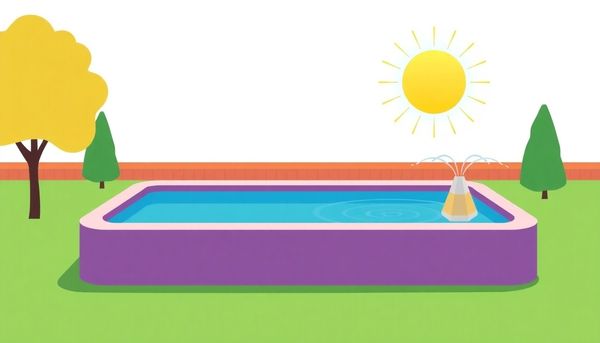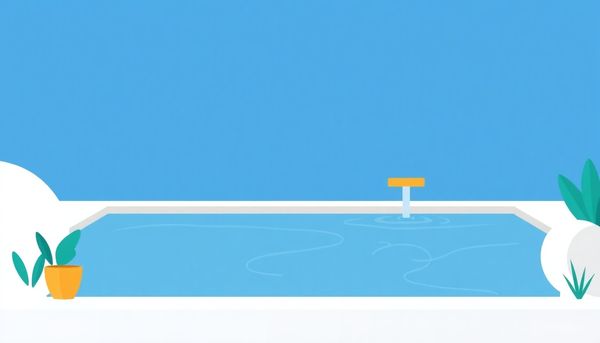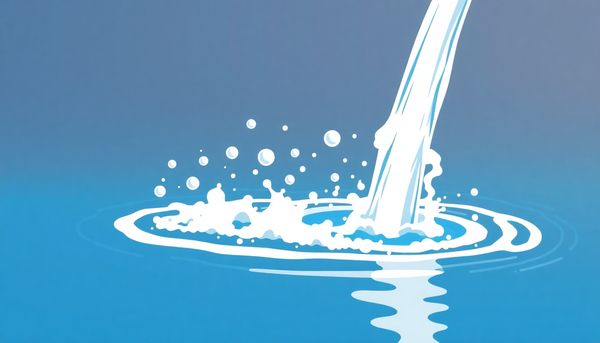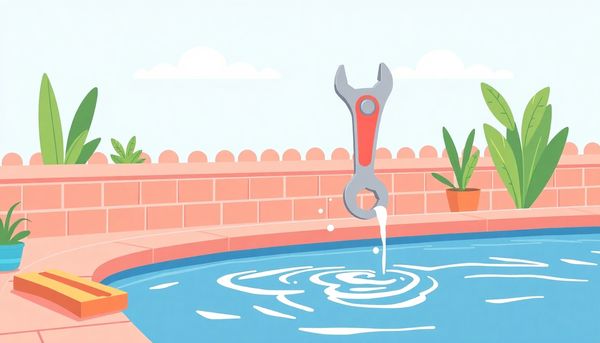Keep Your Pool Cool: The Essential Guide to Pool Aerators
October 08th, 2024
October 08th, 2024
A shimmering pool on a hot day is like an oasis of refreshment, but what happens when that sparkling haven turns into a tepid bath? This is where the often-overlooked pool aerator comes into play. Many pool owners have stumbled upon this device in their quest to maintain clear, cool water, yet its true function and value remain shrouded in mystery for many.
I remember a friend, Alex, who battled with maintaining his pool's temperature every summer. He would try everything from ice blocks to large umbrellas. Then, he heard about pool aerators—a simple device that can dramatically change the way your pool feels. By circulating air and reducing water temperature, an aerator can help keep your pool cool and inviting, even during the most sweltering days.
Understanding a pool aerator isn't just about knowing its mechanical components; it's about recognizing its role in enhancing your swimming experience. Imagine having a backyard retreat that consistently feels refreshing, without the use of cumbersome gadgets or excessive energy consumption. Furthermore, the benefits extend beyond mere temperature control; aerators can also improve water quality by promoting better oxygenation, thus keeping algae and bacteria at bay.
In essence, pool aerators provide a cost-effective solution to common pool problems, allowing owners to maximize their enjoyment and minimize maintenance headaches. As we delve further, let's explore whether this unsung hero of pool maintenance truly lives up to its promise.

On a sweltering summer afternoon, when the pool's water feels more like a tepid bath than a refreshing escape, the allure of a pool aerator becomes undeniable. Unlike other cooling solutions that might require a complicated setup or hefty investment, aerators offer a straightforward approach to reinvigorating your water. By injecting air into the pool, these devices not only cool the water but also enhance circulation, ensuring that every swim feels like a revitalizing plunge.
Think of a pool aerator as a small, yet mighty waterfall. Affixed typically to the pool's coping or deck, it effortlessly connects to the return line, transforming ordinary pool water into a lively stream enriched with oxygen. This increased oxygen level aids in distributing chemicals more evenly, keeping your pool healthy and balanced. Moreover, as the aerator operates, the water temperature can drop by 3 to 4 degrees Fahrenheit, an impressive feat for such a modest device.
For those residing in relentlessly hot climates, where the battle to maintain a cool pool seems never-ending, aerators prove particularly beneficial. Running them during the nighttime takes advantage of cooler air, speeding up the temperature reduction. However, their utility is not limited solely to cooling. Aerators also tackle issues like low pH and circulation inefficiencies, making them an essential tool in any pool owner's arsenal. Whether your pool is large or small, inground or above ground, integrating an aerator can transform your swimming experience from placid to pristine.
Setting up a pool aerator can be as straightforward as assembling a puzzle with clear instructions. Start by making sure your pool's return line is in good working order. You'll want to connect the aerator to this line, which helps it effectively distribute water and air. Most aerators come with a swivel attachment, allowing you to direct the flow of water into a cascading fountain or keep it submerged when not in use. This flexibility means you can adjust the aeration based on your pool's needs or your personal preference.
While connecting the aerator, consider securing it to the pool's coping or deck. This positioning not only stabilizes the aerator but also maximizes its ability to pull in air, helping to cool the water efficiently. The dedicated valve included with most setups offers the chance to control the water flow, letting you play around with different settings to find the perfect balance for your pool environment.
Personal anecdote time: a friend once mentioned that after installing his aerator, he noticed a significant difference during the scorching summer months. His pool went from feeling like a lukewarm bath to a refreshing escape, thanks to the aerator’s cooling effects. If you have any concerns, always refer to the manufacturer's instructions for specific guidance tailored to your device. Enjoy the refreshing change it brings to your pool, making those hot days far more enjoyable.
When the sun relentlessly beats down, turning your pool into a tepid bath, the magic of optimal water temperature can feel like a distant dream. But fear not, for the pool aerator is here to transform that scenario. Imagine stepping into your oasis, the water crisp and refreshing, rather than stiflingly warm. Aerators work by drawing air into the water, creating a cooling effect as the air disperses, much like a gentle breeze on a hot day.
Running the aerator at night can maximize this cooling effect. As the sun sets and the air cools, the aerator's continuous stream of air mixing with water works wonders in lowering the pool’s temperature. A reduction of 3 to 4 degrees Fahrenheit can be a game-changer, especially during the dog days of summer. This process not only cools the water but also enhances circulation, ensuring a more even distribution of chemicals.
In climates where humidity lingers long after sunset, options like misters might complement your aerator, offering additional cooling. While adjusting your pool’s temperature might seem like a balancing act, an aerator provides you the flexibility to maintain comfort even in the height of summer. Just remember, too much of a good thing is possible; over-aeration can lead to excessive cooling or increased evaporation. With a bit of fine-tuning, you can perfect your pool's temperature, making each swim a refreshing reprieve.
Sweltering summer afternoons often find pool owners grappling with a familiar issue: uneven water circulation. While the pool's filtration system tirelessly works below the surface, it's the aerator that takes the spotlight, offering a little magic trick to ensure every corner of your pool gets its fair share of cool, oxygen-rich water. An aerator isn’t just a pretty face; it’s a powerhouse of functionality. By injecting air into the water, it not only enhances the immediate surface sparkle but also diligently assists in moving water around, preventing those pesky stagnant areas where algae loves to gather.
In my own backyard, the aerator transformed my pool from a sun-drenched bathtub into a refreshing oasis. Before its installation, I noticed certain areas, particularly near the steps, seemed to remain warmer and were prone to the growth of green scum. Once the aerator was up and running, the change was palpable. The water felt more invigorating, and I could visibly see the increased movement at the pool’s surface, a telltale sign of improved circulation.
It's like giving your pool a gentle nudge, ensuring that the sanitizer reaches every inch, and the heat disperses more uniformly. Whether you're lounging on a float or diving into the deep end, the aerator ensures that each splash is as refreshing as the next. For those who take their pool's health seriously, investing in an aerator isn't just about cooling down; it's about elevating the entire aquatic experience.

Stepping into the backyard on a scorching summer afternoon, there's nothing quite like the cool embrace of pool water. But what if your pool feels like a tepid bath? That's where a pool aerator comes into play, not just as a luxury but as a vital component in improving water circulation. By infusing air into your pool, aerators help oxygenate the water, which is key to both cooling it down and ensuring even distribution of chemicals. This process keeps your pool water from becoming stagnant and uninviting.
Take, for example, the scenario of a friend who installed a pool aerator last summer. Located in Arizona, their pool was more of a hassle than a haven due to relentless heat. After integrating an aerator, the water temperature noticeably dropped by several degrees, making it far more refreshing. The difference wasn't just about comfort; the aerator enhanced the pool's overall circulation, preventing the buildup of debris and unsightly scum lines.
Every pool, regardless of its filtration system, can benefit from improved circulation to combat problem areas where water might otherwise stagnate. Aerators work alongside your existing pool equipment, adding an extra layer of movement to the mix. Moreover, they do so with an appealing visual effect, often creating a pleasant waterfall feature that complements your outdoor space. So for those battling the heat or uneven water quality, a pool aerator isn't just worth it—it's a game-changer.
Embracing the idea of installing a pool aerator can feel akin to adding a fresh breeze to your backyard oasis. I recall helping my friend with his pool setup during a sweltering summer week. We quickly realized that a pool aerator was not just a luxury but a necessity for survival against the relentless heat. This nifty device, a savior for pool enthusiasts in warmer climates, deserves a place on your poolside.
To begin the installation process, ensure you have a firm understanding of your pool's setup. Aerators typically connect to your pool’s return line. If your pool’s return system has a dedicated valve, you're in luck; this makes adjusting water flow seamless. Attach the aerator to the side of your pool, perhaps on the deck or coping, ensuring it is secure and aligned correctly to create that coveted cascading waterfall effect.
Remember, the beauty of a pool aerator lies in its simplicity and effectiveness. Its design allows you to adjust it with ease, whether you want a gentle ripple or a vigorous stream. During those nights when the air is cooler, turn on your aerator to maximize its cooling effects. This simple action can transform a warm pool into a refreshingly cool escape. Just like adjusting a fan to the perfect breeze on a hot day, a pool aerator provides that same relief for your pool, making every swim a delightful dip.
Harnessing the full potential of a pool aerator requires more than just installation; it demands a strategic approach to aeration techniques. During my own pool adventures, I discovered that timing is crucial. Operating the aerator during the cooler evening hours not only enhances the cooling effect but also optimizes the oxygenation process. The cooler nighttime air allows for better heat dissipation, dropping the water temperature more efficiently than during the heat of the day.
Another tip is to adjust the aerator’s angle to maximize surface agitation. This adjustment can significantly improve circulation throughout the pool by ensuring that stagnant pockets are minimized. When I initially set up my aerator, I noticed a remarkable difference in water clarity by simply tweaking the angle to target less active areas.
Moreover, integrating other pool features can amplify the benefits of aeration. For instance, if your pool already boasts fountains or waterfalls, running these features alongside your aerator can boost overall efficiency. They work in tandem to enhance circulation and cooling without the need for additional equipment.
Lastly, regular maintenance of your aerator is vital. Debris build-up can hinder its performance. I make it a point to routinely check and clean the aerator, ensuring it operates at peak efficiency. Proper care not only maintains its functionality but also extends its lifespan, safeguarding your investment for many summers to come. By implementing these techniques, you can enjoy a cooler, cleaner pool with minimal effort.
There's more to pool aeration than just cooling the water; it plays a pivotal role in enhancing water circulation. In my own backyard oasis, I once underestimated the power of a simple aerator. With the sun blazing overhead, my pool would become a tepid bath by midday, leaving me reluctant to take a dip. Adding an aerator transformed things remarkably. The constant movement of water not only refreshed the temperature but also improved circulation, ensuring that chemicals were evenly distributed throughout the pool.
Unlike stagnant water which can breed algae and bacteria, aerated water remains vibrant and inviting. This movement is crucial, especially in pools that tend to have 'dead zones' where water circulation is poor. The aerator’s stream pulls water from lower depths and propels it into the open air, mixing layers and preventing the build-up of scum lines along the pool's surface. Moreover, this oxygenation process elevates the water's health by boosting its oxygen content, a benefit that extends beyond the pool's perimeter to improve the overall swimming environment.
For those in particularly hot climates, an aerator is not just a tool but a necessity. It can be the difference between a shimmering, refreshing pool and a stagnant, warm pond. Consider it an investment in comfort and enjoyment, ensuring that every swim is as refreshing as the last.

Sweltering summer afternoons often make the backyard pool feel more like a bath than a refreshing oasis. For those seeking a breath of cool relief, a pool aerator might just be the unsung hero. Unlike bulky cooling systems, aerators are sleek devices that attach to your pool's deck or coping and connect to the return line, turning your water into a cascade of cooling bliss. Imagine the gentle hiss as water is sprayed into the air, mixing with oxygen and plummeting back into the pool, lowering its temperature by a few precious degrees.
A friend of mine, living in the arid heat of Arizona, swears by his aerator. He recounts how running it overnight, when the desert air cools, has turned his pool into a refreshing retreat, knocking off those stubborn few degrees that make all the difference. The trick, he says, is leveraging the night’s cooler air—an ingenious way to harness nature for practical pool cooling.
While pool aerators are particularly beneficial in hot, dry climates, they aren't miracle workers in every scenario. High humidity or consistently warm night temperatures might not yield the drastic drop you desire. Yet, for many, the combination of improved circulation and slight cooling is enough to warrant the investment. In essence, a pool aerator offers a simple, effective solution to keep your swim refreshing without diving into costly alternatives.
In the world of pool maintenance, the installation of a pool aerator is akin to adding a secret ingredient to a favorite recipe—subtle yet transformative. The beauty of a pool aerator lies in its simplicity and effectiveness. Begin by familiarizing yourself with the layout of your pool's plumbing system. The aerator connects to the return line, which is responsible for circulating water back into the pool after it’s been filtered.
Once you’ve located the return line, it’s time to attach the aerator. Most models are designed to be easily affixed to the pool’s deck or coping, and they come with user-friendly instructions. Typically, this involves securing the aerator to your desired location and ensuring a snug fit with the return line. The key here is to guarantee that all connections are tight, preventing any leaks.
With the aerator securely in place, you’ll then adjust the dedicated valve to control the flow of water. This is where you can tailor the aeration to suit your pool’s needs. On sweltering summer days, a higher flow can provide more cooling, while during cooler nights, you might opt for a gentler stream. Remember, the goal is to enhance circulation and lower temperatures without creating excessive water loss through evaporation.
After everything is set, give it a test run. You’ll soon savor the benefits of enhanced circulation and cooler water, all from a straightforward installation process—no professional help required. It’s a small investment of time for a significant upgrade in pool comfort and maintenance.
There's a certain magic in watching water move gracefully, a beauty that pool aerators capture while offering practical benefits. Beyond creating a mesmerizing water feature, aerators play a crucial role in enhancing the circulation of your pool’s water. When installed, this device becomes part of the very pulse of your pool, continuously moving water and maintaining its freshness. Unlike return jets that simply push water around, an aerator injects life into the water by drawing in air, ensuring a continuous dance of movement at the surface.
The secret lies in the unique way an aerator introduces oxygen into the water, invigorating its flow and promoting more effective chemical distribution. This improved circulation helps prevent the annoying build-up of stagnant water and scum lines, which can be an eyesore and a hassle to clean. It’s akin to shaking a bottle of sparkling water—the fizz rises, spreads, and revitalizes everything in its path. This action ensures that the circulation system is working efficiently, supporting the filtration process and enhancing the overall health of your pool.
Consider my friend Jake, who lives in the sweltering heat of Texas. After installing a pool aerator, he noticed not only a drop in water temperature but also a significant improvement in water clarity. The aerator's continuous motion stirred up debris that had settled at the bottom, making it easier for the filtration system to capture it. So, whether you're battling the scorching sun or striving for crystal-clear waters, a pool aerator might just be the unsung hero you didn’t know you needed.
Picture a sizzling summer afternoon when the thought of plunging into a refreshing pool is all that keeps you from melting away. Yet instead of a cooling dip, you find yourself immersed in what feels like bathwater. This is where optimizing your pool’s temperature becomes a game-changer. A pool aerator steps in as a hero, especially for those living in blisteringly hot climates where keeping water cool is a constant battle. By spraying water into the air, this simple device encourages evaporation and infuses the pool with cooler air, effectively reducing the water temperature by 3 to 4 degrees Fahrenheit.
In my own backyard, I installed an aerator after realizing my pool water was more suited for a tepid bath than a refreshing swim. I flicked it on one evening, and by morning, the pool was noticeably cooler, allowing for a delightful start to the day. Running the aerator during cooler nights enhances its efficiency since the cooler air temperature speeds up the chilling process. Remember, if your nights are as warm as the day, an aerator might not meet your expectations, and you may need to consider additional cooling solutions like a pool chiller.
However, balance is key. Excessive use of the aerator could leave you shivering in unexpectedly chilly water or lead to water loss through evaporation. Monitoring and adjusting the aerator use ensures your pool stays at the perfect, inviting temperature, making every swim invigorating.

Getting a pool aerator up and running can be as straightforward as setting up a new garden hose. Begin by selecting a suitable spot on your pool deck or coping, which will support the aerator’s connection to your return line. Most aerators come with a swivel design that makes installation less cumbersome. With just a few twists, the aerator can be secured in place, ready to transform your pool into a cooling oasis.
From my own experience, a late summer installation required no more than a couple of basic tools—a wrench and screwdriver. First, turn off the pool pump to avoid any unexpected splashes. Then, attach the aerator to the return line, ensuring the flow of water aligns with your desired direction. Don’t forget to check for any leaks; a good seal is crucial for optimal performance. Typically, twisting a few dials will allow you to adjust the water pressure and angle to perfection.
Once installed, it’s all about testing and tweaking. On a particularly sweltering day, I noticed the water’s surface temperature drop by nearly four degrees Fahrenheit after just one hour of operation. The nighttime is your ally here—cooler air helps maximize the aerator’s effect. With a little patience, you’ll find the sweet spot that keeps your pool refreshing without the chill of over-aeration. Embrace the simplicity and enjoy a more comfortable swimming experience.
Cooling a pool in the sweltering heat can feel like trying to keep an ice cream cone from melting in the sun. Fortunately, there are a variety of effective methods to keep pool water refreshing, and each has its unique charm. Besides the trusty pool aerator, which transforms your pool into a bubbling oasis, there are a few other cool tricks to consider.
First, consider integrating a pool chiller. This device acts like an air conditioner for your pool, significantly lowering the water temperature by 8 to 10 degrees Fahrenheit. Although it involves a more significant investment than an aerator, the relief it provides during peak summer heat can be well worth it.
Another method is the installation of misters around the pool area. These fine sprays not only cool the surrounding air but also gently lower the water temperature as they mist over the surface. They’re particularly effective in dry climates where evaporation rates are high.
Don’t overlook natural shade and landscaping as part of your cooling strategy. Strategically planted trees and shrubs can provide much-needed respite from direct sunlight, casting cooling shadows over your pool. Combined with water features like fountains, which naturally aerate and cool the water, these methods create an aesthetically pleasing environment that feels cooler just by being there.
Each of these approaches, whether quirky or conventional, offers a unique way to enhance your pool’s cooling capabilities. Consider your climate and pool setup to choose the most suitable method, ensuring that every dip is as refreshing as the last.
Few things transform a backyard into a personal oasis like a swimming pool, shimmering under the sun. However, maintaining such a paradise, especially in hotter climates, can be a challenge when pool water turns uncomfortably warm. Enter the pool aerator, an unobtrusive yet powerful tool that enhances water circulation and keeps temperatures in check.
My friend Sarah, who lives in the Texas heat, swears by her pool aerator. It's a simple attachment to her pool's return line, creating a gentle waterfall effect that not only cools her pool water but invigorates it with oxygen. This infusion of air helps prevent water stagnation, ensuring even chemical distribution and reducing the risk of unpleasant scum lines. In fact, she noticed her pool's overall health improved, with fewer chemical adjustments needed.
When the aerator runs at night, cooler ambient temperatures synergize with the device to affect a noticeable decrease in water temperature, often by 3 to 4 degrees Fahrenheit. This cooling effect is not just a relief for swimmers but also a boon for maintaining optimal pool chemistry.
For those without fancy water features, a pool aerator offers similar benefits. Despite its simplicity, this tool proves invaluable in preserving your pool's comfort and cleanliness. So, if you're dealing with persistent heat or circulation woes, consider this unsung hero of pool maintenance. It might just save your summer.
When it comes to keeping your pool's water in balance, over-aeration is a pitfall to avoid. While aerators are beneficial for cooling water and enhancing circulation, they can inadvertently push the water chemistry into a problematic zone. If you've ever tried adjusting your pool's pH, you know how delicate this equilibrium can be. Over-aerating can cause your pool’s pH levels to rise too high, which can lead to scaling, cloudy water, and inefficient chlorine. This not only affects the health of your pool but can also damage your equipment over time.
A friend of mine once ignored her pH levels after installing a new aerator, thinking it would only bring positive effects. Within weeks, she noticed a rough, white scale forming around her pool tiles—a clear sign of calcium carbonate deposits. It turned out her pH had climbed above the recommended range, thanks to the enthusiastic aerator. Regular testing of pH and alkalinity, ideally weekly, is crucial. A testing kit is your best ally in this situation, letting you act before issues arise.
To prevent over-aeration, monitor and adjust the aerator's usage based on the water’s needs. Sometimes, less is more. If you're using other water features like fountains or spas that add oxygen, consider turning off the aerator periodically. Balancing these elements keeps your pool refreshing and prolongs the life of your equipment.

Selecting the ideal pool aerator involves a bit more than just considering its cooling capabilities. Each pool has its own quirks, much like an old friend, and understanding these quirks can guide you to the perfect match. First, take into account the climate of your location. If you reside in a region where the summer sun feels like it's trying to fry eggs on the sidewalk, a robust aerator might be just what you need to transform your pool into a refreshing oasis.
Next, think about the size and type of your pool. Above-ground pools, especially those that bask in direct sunlight, tend to heat up more quickly than their inground counterparts. For such pools, a dedicated aerator can work wonders in maintaining a comfortable temperature. However, ensure you have a suitable setup, such as a deck, to accommodate this addition. If not, a mister might be a more feasible alternative.
Consider your existing pool features as well. You might already own an aeration system without realizing it. Deck jets, fountains, and waterfall features naturally introduce oxygen into the water, aiding in cooling and chemical distribution. In some cases, the clever angling of return jets can efficiently enhance aeration without additional equipment.
Finally, think about your pool's maintenance needs and your personal habits. Do you often find yourself battling high pH levels? Aeration could assist in balancing that scale without affecting alkalinity. By understanding your pool's specific requirements, you'll ensure the system you choose not only benefits your water's health but also elevates your swimming experience.
Seeing your pool transformed with a refreshing aerator is simpler than you might expect. With the right tools and a little patience, you can savor the benefits of cooler and better-circulated water in no time. Begin by gathering essential tools: a wrench, Teflon tape, and a screwdriver. These will come in handy as you embark on this minor yet impactful DIY project.
First, identify an appropriate spot on your pool's return line. This is where the aerator will connect and work its magic. Most aerators come with a simple attachment system designed to fit seamlessly. Secure the aerator in place, using Teflon tape on threaded areas to ensure a snug, leak-free connection.
Once you've attached the aerator, it's time to adjust the flow. This is usually done via a dedicated valve that allows you to control how much water streams through the device. Experiment with different flow levels to find the perfect balance that cools the water effectively without over-aerating, which might lead to unexpected water loss from evaporation.
Finally, test your handiwork by running the aerator, preferably in the evening when the air is cooler. Watch as the gentle cascade of water invigorates your pool, lowering the temperature and enhancing circulation. Not only will you enjoy a more comfortable swim, but you'll also notice improvements in chemical distribution, making maintenance a breeze.
Sweltering summer afternoons by the pool are a favorite pastime, but when the water feels more like a warm bath, it's time to rethink your setup. A pool aerator, often overshadowed by more elaborate water features, can be the unsung hero in optimizing water circulation and maintaining ideal swimming conditions. I recall visiting a friend’s house one blistering July day; his pool was refreshingly cool, thanks to a discreet aerator quietly working its magic.
Incorporating an aerator into your pool system isn’t just about temperature control. It plays a pivotal role in enhancing water movement, a crucial factor often underestimated by pool owners. Increased circulation not only keeps the water cool but also prevents stagnation, ensuring that your pool chemicals distribute evenly. This means less time worrying about algae blooms or that pesky scum line forming at the water’s edge—a common eyesore when water circulation is inadequate.
By improving water flow, aerators also contribute to the overall health of your pool. They reduce the workload on your existing filtration system, potentially extending its lifespan. This is particularly beneficial for above-ground pools or smaller setups where filtration may not be as robust. For those living in particularly warm climates, installing a pool aerator might just be the most refreshing upgrade you make this season.

This article provided insights into maintaining your pool. Start your pool care journey today!
Want to become a pool maintenance expert? Our free Pool School course covers everything you need to know about pool care. From basic maintenance to advanced troubleshooting, you'll learn how to:
Join over 10,000 pool owners who have already transformed their pool care routine. Get started with our free Pool School course today!